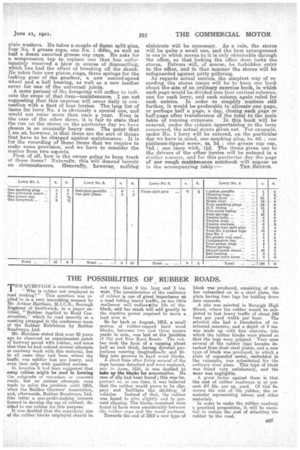THE POSSIBILITIES OF, RUBBER ROADS.
Page 35

If you've noticed an error in this article please click here to report it so we can fix it.
THE QURST1ON is sometime's asked, " Why is rubber not employed in road snaking?" This question was replied to in a very interesting manner by .Mr. Arthur Harrison, M.I.C.E., Borough Engineer of Southwark, in a paper entitled, "Rubber Applied to Road Construction," which he read recently at a meeting arranged in the conference room of the Rubber Exhibition by Rubber Roadways, Ltd.
Mr. Harrison stated that over 30 years ago he observed an experimental patch of footway paved with rubber, and since that time he had noticed several attempts at roadway work with this material, but in all cases they had been where the traffic was neither fast nor heavy, and even then only with qualified success.
In America it had been suggested that swap rubber might be used in forming the subgracie os macadam or concrete roads, but no serious attempts were made to solve the problem until 1914, when the Rubber Growers' Association, and, afterwards, Rubber Roadways, Ltd. • (the latter a non-profit-making concern formed to develop the use a rubber), decided to use rubber for this purpose. It was decided that the superficial size of the rubber blocks employed should be not more than 9 ins, long and 3 ins. wide. The consideration of the resiliency of rubber is one of great importance on a road taking heavy traffic, as too little resiliency will reduce *the life of the block, and too much will add greatly to the tractive power required to move a load over it.
So far back as August, 1913, a small section of rubber-capped hard wood blocks, between two and three square yards in area, was laid at the junction of Old and New Kent Roads. The rubber took the form of a capping about half an inch thick, having dovetail projections running longitudinally and fitting into grooves in hard wood blocks.
A short time after fixing several of the caps became detached and were replaced, and in June, 1915, it was decided to tale up the blocks for examination. No case of slip had been found; this was important as, at one time, it was believed that the rubber would prove to be slippery and facilitate the skidding of
vehicles. Instead of that, the rubber was found to give slightly and to prevent slipping. The blocks examined were found to have worn considerably between the rubber caps and the wood portions. Towards the end of 1918 a new type of block was produced, consisting of rubber vulcanized on to a steel plate, the plate having four lugs for holding down into concrete.
A site was selected in Borough High Street, where the rubber would be subjected to fast heavy traffic of about 240 tons per yard width per hour. The selected site had a foundation of reinforced concrete, and a depth of 4 ins. was made up with fine, concrete, into which the rubber blocks were placed co that the lugs were gripped. Very soon several of the rubber caps became detached from their steel plates, and a new type of block was procleced, in which a plate of expanded metal, embedded in the vulcanite, was substituted for the ordinary steel plate. This type of block was found very satisfactory, and the wear was negligible.
A great factor against them is that the cost of rubber roadways is at present 24 16s. per sq. yard. Of this 6s. covers the cost of the rubber, the remainder representing labour and other materials.
In order to make the rubber roadway a practical proposition, it will be essential to reduce the cost of attaching the rubber to the road.






































